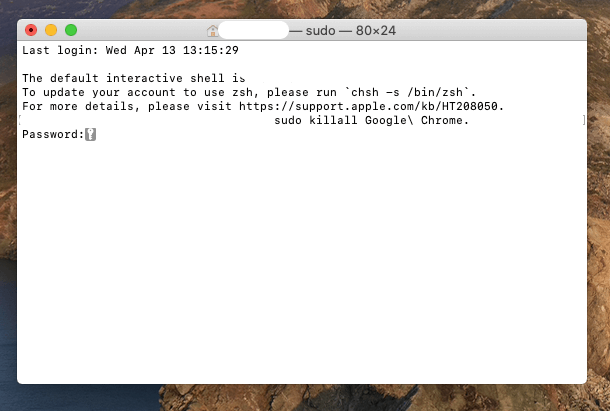

- FORCE QUIT ALL RUNNING APPLICATIONS MAC TERMINAL HOW TO
- FORCE QUIT ALL RUNNING APPLICATIONS MAC TERMINAL SOFTWARE
- FORCE QUIT ALL RUNNING APPLICATIONS MAC TERMINAL WINDOWS
To do so, follow these steps as outlined: Try to force close the app in question using the activity monitor. Hence, you might need a different approach.


However, there are times when some apps persistently won’t close.
FORCE QUIT ALL RUNNING APPLICATIONS MAC TERMINAL HOW TO
Most of the above methods for how to force quit on Mac should work in most cases. How to Force Quit on Mac Using Activity Monitor # If the previous methods are giving you no luck, try this other way using the option key and your dock. How to Force Quit on Mac Using the Option Key # You can also use this for a quicker force quit than the first method.
FORCE QUIT ALL RUNNING APPLICATIONS MAC TERMINAL WINDOWS
Former Windows users should be familiar with this because it’s the same as Ctrl+Alt+Delete but on Mac. If so, it’s time to learn how to force quit on Mac using keyboard shortcuts. Sometimes, Apple’s regular method doesn’t work. How to Force Quit on Mac Using Shortcut Keys # This method tells you how to force quit on Mac using the Apple menu. The first method is the regular method Apple recommends. How to Force Quit on Mac Using the Apple Menu # Other times, you need more in-depth approaches to force-quit apps. For instance, some may be good methods for normal cases. Not everything is ideal for different circumstances. The only difference is the means and tools you use. However, all of them do essentially the same thing. With all of that said, let’s turn to the numerous ways to learn how to force quit on Mac. How to Force Quit Unresponsive Apps on Mac # If your apps regularly stop responding, there may be a bigger problem you have to solve. That’s why learning how to force quit on Mac is only a temporary solution. However, some of these solutions (like hard-resetting your Mac) can cause other issues you don’t want to have. In those cases, you might resort to more drastic measures to get your computer to work again.
FORCE QUIT ALL RUNNING APPLICATIONS MAC TERMINAL SOFTWARE
However, it only affects files and software related to the app you were running.įurthermore, sometimes learning how to force quit on Mac doesn’t always solve the problem. In the worst-case scenario, you might corrupt some of the files in your hard drive. However, force-quitting coerces the app to close causing all background performances to stop without proper protocol. Normal means of closing apps clean the things that are running behind the scenes. Force-quitting doesn’t have that feature and, therefore, might cost you hours of work.Īnother reason why force-quitting isn’t healthy is because of things running in the background. When you quit apps normally, the app asks you to save your work. Why? Well, because knowing how to force quit on Mac and doing so forcibly closes apps without running the proper procedures. However, don’t get used to doing it because it can result in corrupted files and data loss. If you’ve learned how to force quit on Mac, it may become a useful tool for troubleshooting problems. It’s not always safe to force-quit apps, especially if you’re using last resort options. However, when you force quit on Mac in general, it can cause problems. When you have macOS force-quit apps, it solves the immediate problem of your apps not responding. Therefore, you shouldn’t worry that learning how to force quit on Mac won’t work on Finder or other apps. Most importantly, knowing how to force quit on Mac also applies to almost any app there on macOS. That’s especially so if you’re running newer software on older hardware.įortunately, learning how to force quit unresponsive apps on Mac is beneficial regardless of the hardware’s age.

However, if you’re running an older Mac, even simpler tasks and apps may crash from time to time. If all you’re working on are document files and spreadsheets, chances are your app won’t crash as much. Does Force Quit Work on Every App on Mac? #


 0 kommentar(er)
0 kommentar(er)
